Femoral nerve case file
Femoral nerve case file has severe pain in the front of the thigh, and often the groin too.
The innervation of the legs:
- Sciatic nerve - roughly it supplies the back of the thigh and calf, and the foot, and raises the heel and the big toe from the ground.
- Femoral nerve - in the main it affects the front of the thigh and the inner lower leg, and especially the quadriceps muscle that extends the knee.
The page was last updated on 12th May, 2019.
Only 10 percent of lower back surgery involves the femoral n. which emerges higher in the lumbar spine than the sciatic n. and it often involves degenerate facet joints, rather than disc prolapse. However, yours truly has just suffered a sequestered disc causing severe femoral nerve damage and upper leg pain, especially the front of the leg; but it is less common that back of the thigh, calf and foot pain, sciatic nerve.
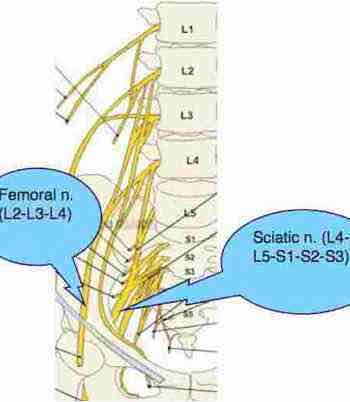
True to the norm, the patient, aged 67, an extremely fit and hard working man experienced sudden onset of acute right lower back pain, whilst tiling the floor, 10 days ago. Previously, he had occasional lower back pain, but nothing of significance.
He consulted a therapist who used an electrical modality, but it worsened, spreading into the groin with anterior, upper thigh pain.
In short, progressive lower back and leg pain.
Examination first, and only then the diagnosis to follow;
a little aside of no little importance. Accept treatment from any
doctor reluctantly, medical or chiropractor, when you know you haven't
been examined properly.
He stood in an awkward acute antalgia, the leaning tower of pisa sign, his back stuck forwards and to the left, obviously in severe pain.
The pelvis was markedly low on the left, possibly due to the antalgic posture.
He denied pain with the so called triad of Dejeurine; whilst coughing, sneezing or straining on the toilet he had no discomfort. Or laughing, not that he had cause for amusement for the last week. Everything was worsening, particularly the burning feeling in the leg.
Forward flexion did not increase the symptoms; in fact it brought a measure of relief. However extension, and particularly leaning to the right, caused very severe pain in the back, groin and front of the leg; the distribution of the femoral nerve, in particular the L2 nerve root.
Femoral nerve case file
Femoral nerve case file occurs more commonly in the older patient with lumbar facet degeneration. A cure doesn't exist and you must exercise daily like you brush your teeth if you want to escape surgery.
The straight leg of Lasegue for a sciatica, was negative, as was the Slump test. However, the femoral nerve stretch was very extremely uncomfortable in the groin and the front of the upper thigh.
My diagnosis is femoral neuritis; the upper leg pain can be excruciating.
Kemp's test for a lumbar facet syndrome was extremely painful, with pain immediately in the anterior upper leg.
There was no sensory disturbance, but the knee jerk reflex was present but reduced. There was no measurable weakness of the quadriceps muscle.
No x-rays had been taken. Probable loss of L2 L3 disc space and degenerative arthritis in the L2 L3 facet right, possibly with a capsular invagination or cyst, and possible antero or retro lysthesis.
The diagnostic possibilities are as follows.
- L2 L3 facet syndrome with radiating pain in the L2 dermatome. Grade 3; loss of reflex.
- Possible L2 L3 far lateral disc prolapse into the foramen, or beyond the foramen affecting the L2 nerve root.
- Possible L1 L2 central disc prolapse affecting the L2 nerve root.
All
speculative in absence of X-rays or MRI. Especially as an extrusion of
the disc into the intervertebral foramen will also produce leg pain on
extension and lateral flexion.
First treatment. Soft tissue therapy to the lower back, lying with the painful side down (he was unable to lie on his belly, prone, even on a cushion). Side posture manipulation with release of L3. Painful cross friction in the groin where the Femoral nerve emerges from under the inguinal ligament.
Home instructions: Ice minimum twice a day, minimal sitting, and our basic lower back exercises for a lumbar facet syndrome.
Mr R left a little happier than he left which is not always the case.
CONSULT #2 (the following day)
Mr R was distinctly better and stood straighter. Extension was only mildly painful but Kemp's test on the right immediately provoked severe leg pain again. The femoral nerve stretch test was still very strongly positive.
Report of Findings
Femoral nerve casefile
I explained very clearly to Mr R the nature of his condition, its seriousness, and how he was standing poised on the verge of lumbar surgery. A hyperactive man, he had to stop.
I explained briefly the philosophy of Chiropractic (he was in such pain that there was no point belabouring the point: he wasn't able to take much in). I set forth the treatment protocol and the three phases of treatment as outlined in consulting a Chiropractor ...
Upper leg pain
Upper leg pain is a big feature of the femoral nerve casefile; sometimes extending to the inner knee and lower leg area. The L2, L3 or L4 fibres may be affected.
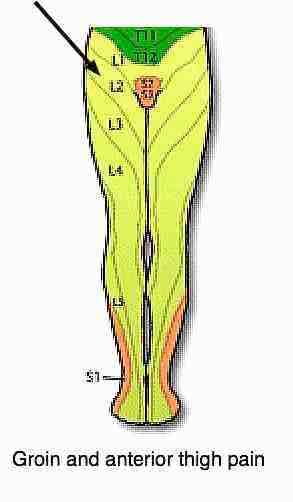
The treatment was much the same as the previous day, except that we added in some electrical stimulation since he had once found that very beneficial. Again, he left a little better.
Seeing a copy of BATS IN MY BELFRY my second Chiropractic book in the waiting room, he bought a copy.
CONSULT #3 (the next day)
Femoral nerve casefile
Mr R is dramatically better. He is no longer in an antalgic posture, though the pelvis is still distinctly low on the left. He reports that standing and walking slowly has been uncomfortable for years. He says the pain is at least 50% less.
Proprioceptive testing:
With his eyes closed Mr R is distinctly unsteady on his feet. A light tap on his outstretched arms made him wobble. A 3mm heel lift did not improve matters, but 3mm under the whole left foot made him far steadier; 6mm even more steady. Nine millimetres made him worse again.
Kemp's Test to the left is now only mildly painful, but the Femoral nerve stretch test is still strongly positive. There was no progressive weakness of the Quadriceps muscle nor numbness in the L2 dermatome in the anterior thigh, though he reports the skin feels a little different.
I add a new exercise. He is still to remain quiet, try walking a little being very careful not to stumble, and to continue with the ice twice a day, and hourly exercises.
I talk about the importance of good care for his back in the future, the need for daily exercises and an occasional but regular treatment, probably once in 6 to 8 weeks. We schedule the next appointment in two days' time.
CONSULT #4 (three days later)
Good news, despite having been a naughty boy! Mr R is hyperactive, and he's renovating an old house. He thought he could do "just a little bit", but quickly realised he couldn't. Sharp stabs in the groin.
Extension is almost painfree, but Kemp R still gives me a little pain in the groin at the end of the range. And he gets little reminders, the odd strange feeling spreading down the front of his thigh.
Patients will often improve faster with a facet syndrome if you can adjust them lying first on one side, and then other. But lying on his left side, he got a stab in the right leg. I hope it didn't aggravate the condition!
He's finished Bats! Un-put-down-able is how he described it. He now wants to download a copy of STONES IN MY CLOG not available in hard copy. You too can download it by going to Amazon if you have a Kindle, tablet or smartphone.
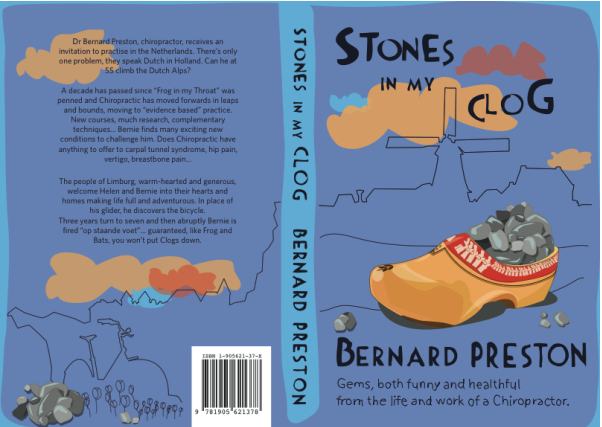
CONSULT #5 (4 days later)
Femoral nerve casefile
Mr R continues to improve. He was indeed slightly worse for a day after the attempt to adjust his spine lying on both sides. At this stage I will continue to adjusting him, lying only on his right side. He is frustrated! He can't work, and idling in neutral is not his strength. I assure him that a severe Femoral Nerve CaseFile like his will take six weeks to heal. He is now able to sit without much pain, and he can lie flat on his stomach on my adjusting table. For the first two-three treatments I had to either prop up his right hip, or lie him only on his right side.
I'm pleased as, lying prone, I can now adjust his pelvis using the Thompson drop protocol.
I add a "hip-hike" exercise.
CONSULT #6 (3 days later)
Mr R can move freely in all directions without pain in his back or leg. The Kemp's test that was so severely positive gives a very slight twinge in the TFL muscle area.
During the day he almost no pain, but nights remain painful. He is in the process of moving house, and has only a mattress on the floor to sleep on. Not ideal.
We add the first of the pelvic stabilisation exercises.
The next treatment will be the last for several weeks: he is moving to Johannesburg, 500km away. The trip will be trying no doubt, but getting onto his proper bed will be an improvement.
ASSESSMENT of this Femoral Nerve Case File
Mr R almost certainly has fairly severe loss of the foraminal space, from a previous injury causing loss of the disc space. The front (inferior) facet then becomes degenerate, often forming a sharp scimitar that threatens the nerve root. It's not impossible that there is a capsular cyst, seen only on MRI, threatening the nerve root. I really should have ordered at least an X-ray and probably an MRI.
Normally a very fit and active man for 67, he admits that he had to finish some extensive repairs on the house he is selling, and for four weeks had worked very long hours, neglecting his exercises and walks that he would normally have done every day.
Mr R has responded extremely well, but his case remains the most painful lower back and leg pain condition I've treated in three months. True nerve pain is severe and his back is still very unstable.
Microdiscectomy Surgery Medicine's approach would normally have been anti-inflammatories for several weeks, followed by physiotherapy and possibly physical therapy. Then after three months, if there had been no satisfactory improvement, he would have been sent for micro-surgery to either remove a portion of the offending facet, and possibly a discectomy if any disc fragments were found around the nerve.
CONSULT #7 (5 days later)
Femoral nerve casefile
Oh dear, Mr R didn't believe me. The next day he felt so good, he started doing more repairs to his house. Carefully, he says. All was well, and he got up the next morning, two-and-a-half weeks after the first consult, with almost no pain. He went to shower, raised his right leg to wash his foot - bingo - a severe stab of pain in the back, radiating straight to the groin and upper thigh again. Very severe pain, he could barely walk, and was again in an antalgic posture.
I had to do a housecall. I ordered X-rays.
COMMENT It's noteworthy that doctors are only there to facillitate the healing process. You are an important part of the healing process, some say YOU ARE THE DOCTOR, but in any event, your full cooperation is vital to achieve an optimal result.
CONSULT #8 (4 days later)
Femoral nerve casefile
Mr R is a little better having spent two days in bed. Still too painful to get downstairs and into the car. I adjust L3 again with him lying only on his right side. Active Release Technique on the psoas major tendon in the upper thigh.
CONSULT #9 (2 days later)
Femoral nerve casefile
Mr R is distinctly better this morning (housecall). He is standing straight again, and Kemp's test produces no pain in the leg. There is no weakness of the Quadriceps muscle (relief!) but the skin is about 50% numb. Tomorrow his sister will take him to the Rad lab. I wonder what awaits me...
CONSULT #10 (4 days later)
Femoral nerve casefile
Mr R was doing very nicely - until he had to lie prone at the radiology department. Immediate severe groin and back pain again. The awaited...
X-rays
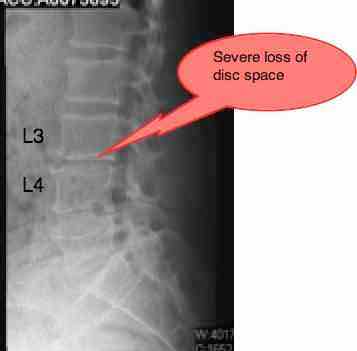
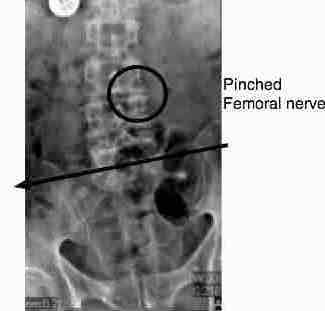
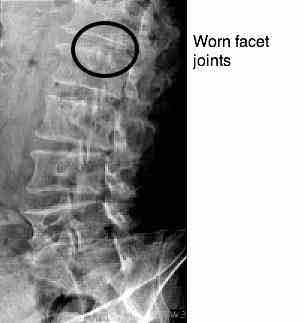
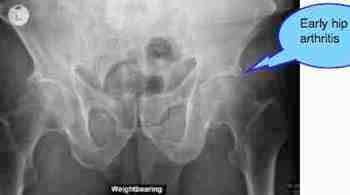
As expected, he has marked loss of disc space at L3-L4, and the oblique reveals degenerate facets at two levels: L1-L2 (hence the groin pain) and L3-L4 (anterior thigh pain).
What muddies the water is the degenerative changes in both hips, worse left. Could that be the cause of the groin pain? An emphatic NO. The range of motion of the hips is full and virtually painfree.
The short left leg is readily visible.
CONSULT #11,12,13
Despite being in great pain again at consult #11 (after the X-ray), Mr R has now accepted that he has to STOP. Also he has found that sitting is far less painful than lying, typical of a facet syndrome, as compared to a disc. I also feel I have the measure of his back. He is rapidly responding well, and staying well. In the main the treatment is a side posture manipulation of L3, lying on the right side.
A happy man, and a relieved chiropractor! The pinwheel examination of his leg is now normal, and even the reflex is improving which is surprising. It often never returns. Extension and Kemp's test is virtually normal, and the femoral stretch test only slightly positive. Happiness!
CONSULT #14 (7 days later)
Happily the improvement continues. Range of motion of his spine is full and free, and in particular extention and right lateral flexion cause absolutely no pain in his leg. He's going to the hip-hop fifty-year reunion of his high school tomorrow... I wonder what next week will hold! He KNOWS just how painful a true pinched nerve can be and I'm hoping he'll be wise!
We have increased his orthotic by another 3mm. The pelvis is still low even with 6mm.
And given him the next core muscle exercise. He's with these exercises for life.
CONSULT #15 (2 weeks later)
Mr R is elated. He went to a Sixties' ball and jived all night with no after-effect; foolish man!
MUSCLE WEAKNESS
Usually these nerve root impingement syndromes affect only the sensory nerve root: pain, tingling, numbness. But occasionally the motor nerve root is affected which is far more serious. Permanent muscle weakness may occur...
Test yourself:
Severe upper leg pain without LBP
I also needs treatment
periodically for lower back pain, but only once for severe upper leg
pain without LBP; it makes for another interesting femoral nerve
casefile[1].
Leg
pain, in the absence of lower back pain is very worrying for the
chiropractor. Generally it leads to lumbar surgery. Here is a casefile
where the patient diligently followed his chiropractor's instructions
and escaped the knife. This time, I, Bernard Preston, am the patient,
and my daughter, a very competent doctor of chiropractic if I say so
myself, is the doctor; with her help I managed to escape the surgeon's
knife.
Useful links
- Leg pain sciatica
- Upper leg, thigh and groin pain
- Valsalva manoever and Dejeurine's triad.
Sitting
The chair with prolonged sitting, especially in a couch or motor vehicle, is the great enemy of these sciatic and every femoral nerve casefile.
On the other hand there is also danger with overly exuberant exercise, especially if it involves bending and twisting, as in washing a motor car, is also potentially problematic, only less so than the chair.
As a patient myself with a very typical femoral nerve casefile, one who sits for several hours a day at the computer, and yet has a love of vigorous physical exercise, my own solution is as follows.
- With great fervour do our lower back exercises faithfully every morning before getting out of bed.
- Allow
sufficient time for healing after an incident; that means several weeks
and sometimes months; it took me personally three months to fully
recover after my own very serious femoral nerve damage; remember the 50 percent less pain rule.
- Going down regularly on one and sometimes both knees when picking something up from the floor, making the bed, gardening and washing the car, for example.
- Regularly get involved in physical activity, recogising
there may be limits; I foolishly lifted a heavy beehive this week on my
own and got away with it; but virtually every day I'm involved in hard
work; treating patients, gardening, beekeeping and gliding. Making a compost pile will test even the strongest back. Raw honey is an addiction; a good one.
Did you find this page useful? Then perhaps forward it to a suffering friend. Better still, Tweet or Face Book it.
